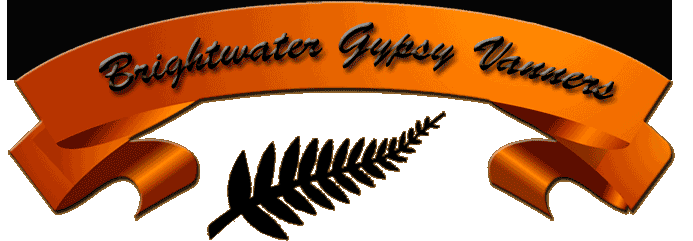Gypsy Vanner vs. Gypsy Cob
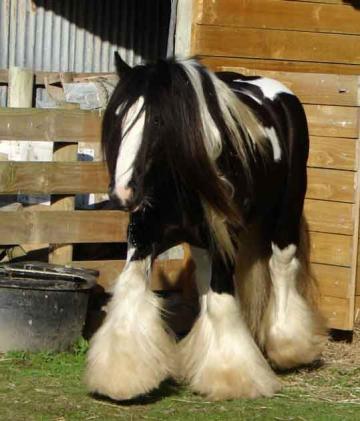
The Gypsy Vanner is known by many other names such as Gypsy Cob, Irish Cob, Tinker, Gypsy Horse, or Romany Cob and it is no wonder that people are confused about the name and what to call these fabulous horses. However, there is a raging debate between the two most commonly used titles, Gypsy Vanner or Gypsy Cob.
Both are technically correct and BOTH were coined by other cultures AND not by the Gypsies themselves. The Gypsies did not have a particular name for their horses and after speaking with 4 top long time breeders Harkers, Fred Luke, Stephen McCartney they confirmed this and terms like "cobber", "good un", "hairy horse" or "proper cob" were all used indiscriminately, but never gypsy cobs. They NEVER referred to their horses by placing the name "Gypsy" in front of the word cob, as many of the Romany people I met in 2005 told me it was an insult. The word Gypsy has been coined or made popular by other cultures, very similar to how the Europeans called them tinkers. The largest face book page for the gypsies to come together in the UK is called Proper Cobs, not gypsy cobs, which is an interesting choice.
I have never been content with the name "gypsy cob" as it is far to wide ranging and generic. After all a cob is a type, not a breed. However, back in 2005 I originally decided not to adopt the name "Gypsy Vanner" due to a breeder in Australia using the "Vanner" name to sell part bred gypsy horses to unsuspecting newcomers as purebreds. Sadly due to this deception the name "Vanner" became associated with a cross bred or an inferior bred gypsy horse in Australia only. It is only here that this has happened, as no where else in the world does the name Vanner refer to a cross bred gypsy horse.
» To Top «
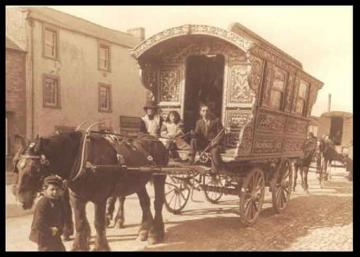
I toyed with the name "traditional", but there is nothing traditional about the characteristics of today's Gypsy Vanners. Take a look at the photo to the right and below in the early 1900's of Gypsies and their caravans. I have yet to find a horse in these old photos that closely resembles a Gypsy Vanner of today. Back then they had large, often roman shaped heads, little or no feather and were more in the size range of 15-17 hands plus, as their vardos/wagons were extremely large and heavy. In short they were just a large, heavy, hack, crossbred horse to pull their caravans and the smaller Gypsy Vanners that the Gypsies breed today could not cope pulling some of these caravans.
» To Top «
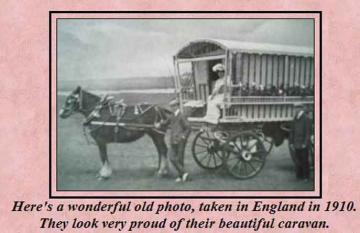
Originally I took the name "gypsy horse" as an alternative to vanner, but it also played on my mind somewhat as I always felt "Gypsy Vanner" was far more befitting and distinct name for this magnificent breed. And like any good haunting the name Gypsy Vanner kept coming back to me and I finally made the decision to go with my heart and changed from Brightwater Gypsy Horses to Brightwater Gypsy Vanners.
» To Top «

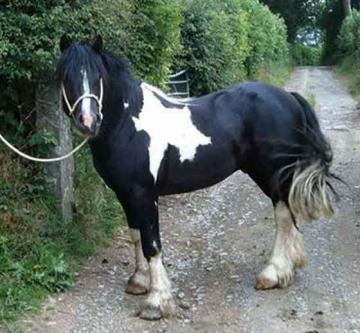
Every breed book that I have researched only describes the cob as a type and not a breed, same goes for the internet. The Ultimate Horse Book published in the UK describes the cob as this...."stocky little horses, big bodied, and standing four square on short, powerful legs". The cob is a type and not a "specific breed". In fact, that description can describe a whole range of cobby type breeds such as the Welsh Pony, the Icelandics, the Fjords and so on and so on. The picture to the right is a coloured Welsh cob and he fits the above description to a tee. Although a very nice horse for his breed, he only has a smattering of feather, thereby not fitting the breed standards nor vision of what the Gypsies have endeavoured to create for generations. However, he could rightfully be classified as a gypsy cob, if the gypsies had bred him themselves. The term "Gypsy Vanner" was an attempt in 1996 by Dennis Thompson to distinguish the Gypsy's endeavours from all other cobby type of horses that they themselves and others breed. Using the terminology gypsy "cob" only serves to contort and diffuses the efforts that the original breeders of this horse had envisioned.
The next three shots were all taken at Horsemonden Fair in 2009, all belonging to gypsies. The horse on the far left in the first picture is the classic stocky little horse, big bodied, and standing four square on short, powerful legs, hence a gypsy cob. The last one, the five year old dapple grey mare, which the gentleman was trying to sell me as a purebred, would be really nice if she had some more feather. Perhaps with a few more generations of breeding to heavily feathered stallions with good bone her progeny may begin to more closely resemble a gypsy vanner by the breed standards of today.
» To Top «
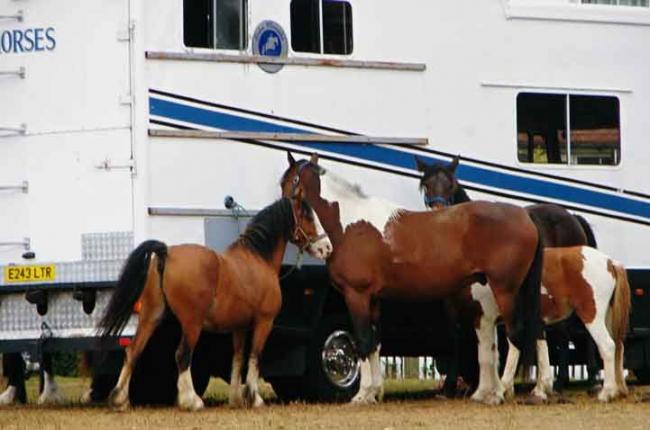
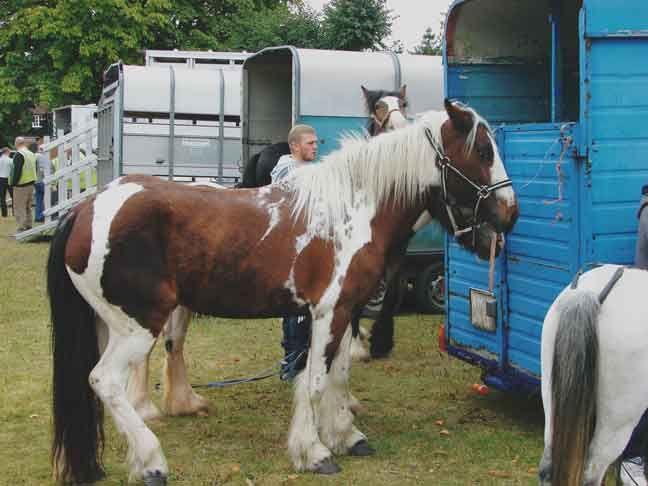
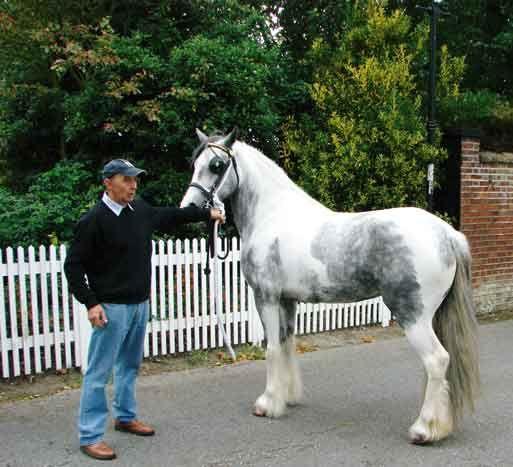
My decision was further reinforced on my last trip to the UK in September 2009. I was privy to visit a lot of the fields were some of the breeders and dealers kept their horses in conjunction with others they breed. Many of those others are just that...."Stocky little horses, big bodied, and standing four square on short, powerful legs", but they are definitely lacking in the traits that we endeavour to breed in a true Gypsy Vanner. However, they are all bred by the gypsies so again, technically they can be called gypsy cobs regardless of what they look like. So this is where the confusion comes in and how does one differentiate between the many different types of cobby horses bred by the Gypsies.
Back in 1996 both Dennis and Cindy Thompson of Gypsy Goldwere the first to import Gypsy Vanners into America. The word vanner was once used to describe a medium weight horse that pulled a cart or van(ner) throughout the cities of England back at the turn of the last century. Although not like the Gypsy Vanners of today, Dennis Thompson adopted the name with his reasoning that these are the perfect cart horse and he is right. Hence the reason for Dennis Thompson's effort since 1996 to establish the name "Gypsy Vanner", with a set of breed guidelines to preserve and protect the Gypsy's vision that they have striven for many generations to create.
» To Top «

Many have seen Dennis Thompsons's attempts to dominate the market as he trade marked the name "Gypsy Vanner" in both the UK and America. Maybe it was, maybe it wasn't as I can only go off of hearsay and nowadays and we all know how versions can be twisted over time. Undoubtedly he was a good marketing man as that was his business and for some reason it created a lot of animosity in the US, when he marketed them. However, when Mac comes out with their newest I-phones, everyone is excited about all the marketing and hype, so why all this animosity in the horse world?
The Gypsy Vanner Society was incorporated in 1996 and 7 yeas later the Gypsy Cob Society was created in the US and the UK in 2003. Dennis Thompson's goal was to protect the name "Gypsy Vanner" from unscrupulous breeders and horse traders who would do exactly what we find today with the cross breeding and selling of inferior cobs under the name, Gypsy Vanner as a selling point. Yes he did market them well, extremely well, but I hold no grudges on the man because I doubt I would have ever discovered these amazing horses if he had not done what he did.
» To Top «
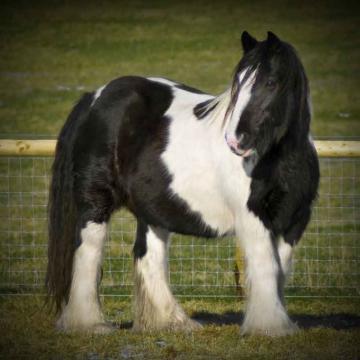
In 2009 while in the UK for the second time. I spoke with Fred Luke who is a true Romany descendant in Kent, now in his 60's. He bred Clara, aka Fenella, now owned by Desert Jewel. We were lucky enough to spot Fenella back in March 2005 with Freed on our first visit before she was sold at Appleby Fair. Fred was kind enough to take us to see her sire, Lenny's Stallion. We spent many hours discussing this topic and it was about 50-60 years ago that certain families began to breed horses to the ideal we see today. As the gypsies will breed a yearling filly, we could in effect be talking about 25 to 45 plus generations of breeding to arrive at what we have today. To take a purebred and cross it back with another heavy breed and then turn around and say you now have a gypsy vanner, is utter nonsense. You are back breeding and undoing what the Gypsies strived for generations to create.
Some defend their positions of crossing purebreds with Clydesdales or other heavy breeds by saying that is what the gypsies did years ago to arrive at this breed and all they are doing is the same. This is partially correct, as the Gypsies did cross with heavier breeds to arrive at the Gypsy Vanner. However the key word is "YEARS" ago, or more to the truth, decades ago.
To further this position, most are aware that the Thoroughbred horse was originally bred from the Arab after MANY generations of selective breeding. However, crossing the two back together does not produce either a purebred Arab or purebred Thoroughbred, what we end up with is a cross, now classified as an Anglo Arab and to arrive back to a purebred status would invoke many generations of careful breeding again. Same applies to the Gypsy Vanner. Crossing back with other breeds is not a Gypsy Vanner anymore, but something that may look similar in certain characteristics, but will take many more generations of careful breeding to advance back to a purebred status and breed true to those genetics.
Eventually the Gypsy Vanner will become a recognised, registered "breed" worldwide and it will be hotly debated as to which name should be used. For me, Gypsy Vanner is the preferred choice as it distinguishes these beautiful horses unique from the typical cob world, which is only a type. Already I have noticed the difference when people ask what breed of horse it is. Back when my two Gypsy Vanners, Beau and Treasure were the first two in New Zealand and relatively unknown, people would ask me what kind of horse it was. I use to reply gypsy cob and the standard retort back was....oh it's a Welsh cob cross or Clydesdale cross. Now when I say Gypsy Vanner, the response is wholly different. People look at me quizzically and want to know more about this amazing breed that they have never heard or seen of before. My changing of names is not an attempt to discredit the use of other names or to say that my horses are betters than anyone else's. It is a decision purely based on a personal choice and one that I am happy to stand behind the Gypsy Vanner name 100%.
More and more I find horse breed websites that list these horses as Gypsy Vanners. We even have NZ stud owners that are ardent promoters of the title gypsy cob that have registered a second domain name with the word vanner in it. Must be a popular name!
Lastly I spoke with two prominent gypsy breeders in the UK on how they felt about the naming and marketing of their horses by Dennis Thompson. Both gave him credit as he made these horses extremely popular as prior to that they were getting a pittance for the majority of their horses. Now they are commanding very good prices, particularly in the height of the craze. They also said they never used the terminology gypsy cob.
I don't care what you call your horse, just allow others to be and make their own choices without all the criticism. I have many friends that call their horses gypsy cobs and breed excellent "cobs" that I would have in my paddocks at a moments notice. I never berate them for using the word cob, that is their personal choice and vice a versa. At the end of the day whether Gypsy Vanner or Gypsy Cob a good un is a good un and no one can take that away from the horse.
» To Top «
This is what the breed is all about!
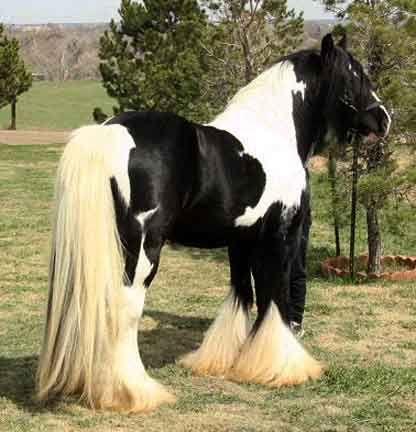
The Lottery Horse:photo courtesy of Black Forest Shires
» To Top «
